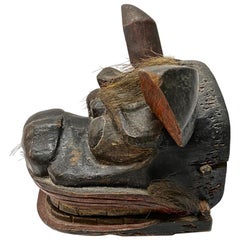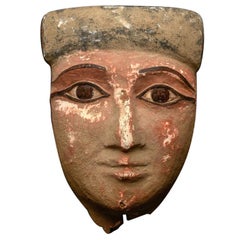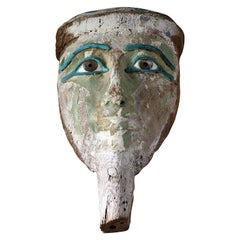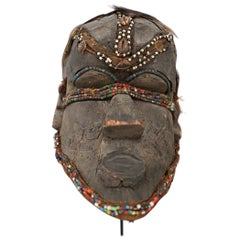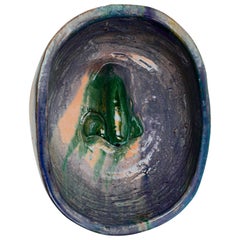18th Century and Earlier Masks
8
to
2
1
8
8
8
8
18
221
19
49
94
27
4
3
2
6
10
22
15
3
3
4
3
2
1
1
3
3
2
2
2
Period: 18th Century and Earlier
Japanese Antique Edo Hand Carved Wood Noh Theater Mask Otobide 17th-18th Century
Located in Studio City, CA
A truly beautiful, wonderfully aged, alluring mask made for Japanese Noh theater. The naturally faded beauty and unique character drew us to this mask immediately.
The mask is handcrafted and hand-carved from natural wood, clearly by a master of his trade.
We believe this mask is of the Noh theatre character Otobide.
This mask dates back to the Edo Period (1603-1868). It comes with a wooden storage box (which may have been added at a later date).
A rare, unique, and exquisite mask. Finely carved and executed. Would be a great addition to any Japanese or Asian art/artifacts collection or an eye-catching stand-alone accent piece in about any setting.
Mask dimensions: 7.7" high, 5.7" wide, 2.1" deep...
Category
Japanese Edo Antique 18th Century and Earlier Masks
Materials
Wood, Lacquer, Paint
Noh Edo Period Lion Mask II
Located in Pasadena, CA
This another superb example of an Edo Period early 18th century or earlier Lion Mask created for the Lion Dances of the Gion Matsuri Festival. The mask is i...
Category
Japanese Edo Antique 18th Century and Earlier Masks
Materials
Wood
Egyptian Mummy Mask, Late Period, ca. 700-30 B.C.
Located in San Pedro Garza Garcia, Nuevo Leon
Carved hardwood mummy mask having a pink-brown painted ground, painted black eyes and brows. Wearing a black headband. Eyes and brows are restored. Scattere...
Category
Egyptian Antique 18th Century and Earlier Masks
Materials
Hardwood
Wooden Mask with Rock Crystal Eyes and Bronze Eyelids/Eyebrows
Located in San Pedro Garza Garcia, Nuevo Leon
Wooden mask with rock crystal eyes and bronze eyelids/eyebrows
Circa: 711-332 BC
Origin: Egypt.
Category
Egyptian Antique 18th Century and Earlier Masks
Materials
Stucco
Kuba Mask African Bwoom Tribal Congo in Wood, Vibrates Vegetables, Animal Hair
Located in Milano, IT
The African Kuba Bwoom tribal mask is the oldest known mask, the Kuba bwoom mask. The materials used for the realization of the Mask are: Wood, colors and vibrates plants, caures, beads, animal hair. In dance it expresses exuberance and joy. The style is similar to that of the middle Kasai. This mask is a helmet with animal hair, carved with a very wide forehead and hollow cheeks that are announced by motifs or dashes and beads. The mouth of the mask is very pronounced carved in wood and then applied on the mask. To distinguish the forehead in different areas are used black and white beads to draw attention to other aspects of the face such as the nose and chin. The entire edge of the chin is surrounded by beads of various colors. The person wearing the mask cannot look because there are no holes for the eyes present; the mask must create the feeling of being blind. Some masks similar to the bwoom mask include the funny mask, the ram mask and initiation masks such as Nnup.
The real Kuba masks...
Category
Congolese Tribal Antique 18th Century and Earlier Masks
Materials
Animal Skin, Organic Material, Wood
Pre-Columbian Chimu Gold Mask With Scar
Located in San Pedro Garza Garcia, Nuevo Leon
A large sheet gold mask depicting a stylized human face having an individually fashioned and applied nose. Large low relief repousse eyes and rectangular mou...
Category
Peruvian Pre-Columbian Antique 18th Century and Earlier Masks
Materials
Gold
Moche Copper Bronze Mask
Located in San Pedro Garza Garcia, Nuevo Leon
A large coper mask of a dignitary with almond shaped, inset shell eyes with pupils and a wide brim type crown. Attached at the brow line, a row of danglers is suspended, aligning the...
Category
Peruvian Pre-Columbian Antique 18th Century and Earlier Masks
Materials
Copper
Pre-Columbian Funerary Gold Mask with Royal Turquoise Beads in its Eyes
Located in San Pedro Garza Garcia, Nuevo Leon
A high karat heavy sheet gold human face mask with large almond-shaped eyes and recessed pierced pupils. Multiple small perforations along the upper and lower edges for attachment. L...
Category
Ecuadorean Pre-Columbian Antique 18th Century and Earlier Masks
Materials
Gold
Related Items
Cariddi, Seminara Ceramic Mask
Located in Paris, FR
In Greek mythology, the name CARIDDI (Charybdis in English) belonged to a monster that lived in the sea between Calabria and Sicily and destroyed ships by swallowing them up and spitting them back out, generating dangerous whirlpools in the water. This myth is reinterpreted in the form of a mask, which inverts the traditional convex surface to create a concave volume inspired by the underwater world. The mask invites the gaze into the blue depths of its smooth interior, where an uncanny protrusion emerges in the shape of a nose, a signature motif in Giovanni De Francesco’s artistic production. Each nose-island is different from the others; every mask has a unique beauty accentuated by imperfections, smudges, and uncontrollable colors, invoking the unpredictability of fear. This perception overturns the ferocious symbolism of the legendary monster, rewriting CARIDDI as a welcoming narrative. The artist’s explorations of fear, danger, and the unknown become particularly poignant when placed in the recent historical context of Calabria and the Mediterranean Sea.
In the exceptional conditions of the present moment, when hundreds of millions of people are spending more time at home than ever before in living memory, the homeware brand TRAME wants to share the inspiring and supportive influences of these Mediterranean ritual objects with the entire world.
The masks, whether the traditional forms or the contemporary design interpretations, reveal a sense of both timelessness and contemporaneity in their aspirational evocation of a social life with more serenity and less fear.
Details:
- Dimension: approximately 28 H x 22 W x 8 D cm
- Material: 100% Mediterranean terracotta clay
- Technique: 100% handmade in Italy
- Each handcrafted CARIDDI Seminara mask is unique. Picture on an indicative basis.
- 14-days return policy
- In stock
Giovanni De Francesco (Bergamo 1976), lives and works between Milan and Paris. He is a visual artist dedicated to sculptural installations through the use of plastic materials, photography, video, painting and sound. Since 1997 he has taken part in many personal exhibits as well as collective ones. He an artistic consultant at the Luisa delle Piane gallery in Milan and is a founding member of the Monstera theatre company.
He occasionally collaborates with Andre Branzi...
Category
Italian 18th Century and Earlier Masks
Materials
Ceramic
Japanese Meiji Noh Mask in Carved Wood
Located in New York, NY
Japanese early Meiji period Noh theater mask made of carved wood with gofun layers. The piece was made in Japan in circa 1880 and is signed on the back. In great antique condition wi...
Category
Japanese Meiji Antique 18th Century and Earlier Masks
Materials
Wood
African Dogon Manner Tribal Face Mask
Located in New York, NY
African Dogon manner tribal face mask, in the style of the Dogon peoples of Mali.
Dimensions: 12" H x 6" W (approx)
Dealer: S138XX.
Category
Tribal 18th Century and Earlier Masks
Materials
Wood
Hand-Carved Wood Javanese ‘Wayang Topeng’ Theatre Mask, Indonesia c. 1900
Located in Jimbaran, Bali
A visibly old mask from the Javanese masks theatre ‘wayang topeng’: carved from hard wood, and painted on the front side. The mask shows clear traces of ...
Category
Indonesian Other 18th Century and Earlier Masks
Materials
Wood
Free Shipping
H 9.85 in W 8.27 in D 4.73 in
Traditional, Seminara Ceramic Mask
Located in Paris, FR
Ditto potters with Antonio Bonamico.
The ceramic masks of Seminara are ostentatious and grotesque, with deliberately frightening features to scare away ...
Category
Italian 18th Century and Earlier Masks
Materials
Ceramic
Early 20th Century Hand-Carved Wood Tribal Mask from Atoni Tribe Timor
Located in Jimbaran, Bali
This very flat mask originates from the Atoni people of Timor. For the Timorese people masks portray both male and female ancestors, worn by warriors to scare off enemies or during c...
Category
Indonesian Other 18th Century and Earlier Masks
Materials
Wood
Free Shipping
H 6.11 in W 5.12 in D 0.02 in
Italian Modern Venetian Handmade Blue and Gold Carnival Mask with Feathers
Located in New York, NY
This Folk Art cobalt blue mask is a real Venetian creation, entirely hand-drawn and handcrafted with gold decor and white stone.
Italian Artists have realized this piece in full res...
Category
Italian Folk Art 18th Century and Earlier Masks
Materials
Metal, Metallic Thread
H 17.5 in W 11 in D 4.5 in
Liberia Bassa Mask
Located in Chicago, IL
Covered with an extraordinary black crusted patina, this wooden Liberian mask was hand-crafted in the style of the Bassa ethnic group. Bassa communities have a number of rich masking...
Category
Liberian Folk Art 18th Century and Earlier Masks
Materials
Wood, Paint
African Lwalwa Tribal Mask
Located in Montreal, QC
African Lwalwa tribal mask enhanced with white pigment on the mouth and ears.
Category
Congolese Vintage 18th Century and Earlier Masks
Materials
Wood
Pre-Columbian Narino Bowl
Located in Washington, DC
Fine Pre-Columbian Narino footed bowl from Columbia, circa 850 to 1500. Desirable polychrome bowl with vibrant color.
Category
Colombian Antique 18th Century and Earlier Masks
Materials
Ceramic
Antique Mexican Demon Mask
Located in Mexico City, CDMX
We offer this rare antique Mexican Demon mask in wood, circa 1970. The mask makes a sound when moved.
Category
Mexican Folk Art Vintage 18th Century and Earlier Masks
Materials
Wood
Tribal Style Songye Kifwebe Mask, D. R. Congo
Located in Point Richmond, CA
This graphic Songye Kifwebe mask has fine carved lines curved over the eyes and diagonal lines radiating from the nose and mouth in classic Kifwebe form. ...
Category
Congolese Tribal 18th Century and Earlier Masks
Materials
Wood
Previously Available Items
18th-19th Century Mask, Arunachal Pradesh, Eastern Himalayas, India
Located in Point Richmond, CA
Mask, Monpa-Sherdukpen people, Arunachal Pradesh, India
A mask from the Monpa/Sherdukpen people of Arunachal Pradesh, which is thought to be a monk or one of the sons of Apapek. I...
Category
Indian Tribal Antique 18th Century and Earlier Masks
Materials
Wood
Japanese Okame Ko-Omote Noh Theater Mask Edo Period
Located in Studio City, CA
A truly beautiful, wonderfully aged, alluring mask made for Japanese Noh theater. The natural faded beauty and unique character drew us to this mask immediately.
This mask is handcrafted and carved from natural wood and lacquer.
Ko-omote translates as "little mask" or sometimes "small face." This particular delicate featured mask (her red lips really stand out) is used for main and sometimes secondary roles when the character is a young girl or, in some cases, a supernatural being. What is also interesting about this mask is that remnants of the blackened teeth can still be seen. Centuries ago, it was customary for Japanese women to paint their teeth black after they were married.
We believe this mask dates from the mid-late Edo period and thus quite rare. The mask was acquired from an antique mask...
Category
Japanese Edo Antique 18th Century and Earlier Masks
Materials
Wood, Lacquer
Japanese Court Dance Mask / Bugaku, circa 1800
Located in Point Richmond, CA
Japanese Court dance mask / Bugaku, circa 1800
This mask was used in a form of traditional court dance known as bugaku during the end of the 18th and early 19th centuries. Traditi...
Category
Japanese Edo Antique 18th Century and Earlier Masks
Materials
Gesso, Hardwood
Bamana Mask "Ntomo", Mali, Africa, circa 18th-19th Century
Located in San Pedro Garza Garcia, Nuevo Leon
Very old African wooden mask with brown patina, resin-like mass with nassa snails on the five tooth-like projecting horns, minor missing parts (chin, nose) and snails, traces of insect caused damage.
This beautiful piece comes with a custom-made stand.
According to Robert Goldwater, former director of New York’s now-defunct Museum of Primitive Art (MPA), He describes Ntomo face masks as "among the most interesting of the Bambara [or Bamana] masks." He recognizes formal variety in the carving of Ntomo face masks, but he also specifies that an "oval shaped human face surmounted by a high comb of vertical spikes or horns" distinguishes Ntomo face masks from other types of face masks.
Research indicates that the Bambara mask...
Category
Malian Tribal Antique 18th Century and Earlier Masks
Materials
Wood
Antique Japanese Noh Theatre Mask, Edo Period, 18th Century
Located in Prahran, Victoria
Antique Japanese carved and lacquered Noh Theatre mask on stand, Edo period, 18th Century.
Dimensions: H 21 cm x W 14 cm x D 8 cm.
Category
Japanese Edo Antique 18th Century and Earlier Masks
Free Shipping
H 8.27 in W 5.52 in D 3.15 in
18th Century Carved Chinese Qing Heads
Located in Buffalo, NY
Monumental carved wood Chinese Qing Dynasty (1644-1911). Head of a Luohan (or Arhat) exceptional carving, black glass eyes custom iron stands.
Category
Chinese Tribal Antique 18th Century and Earlier Masks
Materials
Glass, Wood
Egyptian Late Kingdom Sarcophagus Mask
Located in New Orleans, LA
This amazing wooden sarcophagus mask is a stunning relic from Ancient Egypt. Originally part of a sarcophagus that was meant to forever protect the mummy of the deceased, this enigmatic face hails from the 26th Dynasty of the Late Kingdom. It is carved from a single piece of cedar and bears the original light ocher and black paint, representing the kah, or the image or immortal spirit double of the deceased. Once the mummy was in the sarcophagus, a life-sized image of the deceased was placed over his face. Wooden pegs were used to keep the wooden pieces in place, and the mask was then gessoed and painted with life-like features of hair, eyes, lips and facial color. Such masks were in use well into the Greek Ptolemeic period around 300 B.C.
Masks were a very important aspect of ancient Egyptian burials. In the Egyptians' complicated view of life after death, they provided the dead with a face in the afterlife and enabled the person's spirit, or ba, to recognize the body. Specific features of a mask, including the eyes, eyebrows, forehead and other features, were directly identified with individual divinities. This allowed the deceased to arrive safely in the hereafter, and gain acceptance among the other divine immortals in the council of Osiris, the great god of the dead. Initially made for only the royalty, such masks were later frequently crafted for the nobility. They were also part of the elaborate precautions taken by the ancient Egyptians to preserve the body after death. The protection of the head was of primary concern during this process. Thus, a face covering...
Masks were a very important aspect of ancient Egyptian burials. In the Egyptians' complicated view of life after death, they provided the dead with a face in the afterlife and enabled the person's spirit, or ba, to recognize the body. Specific features of a mask, including the eyes, eyebrows, forehead and other features, were directly identified with individual divinities. This allowed the deceased to arrive safely in the hereafter, and gain acceptance among the other divine immortals in the council of Osiris, the great god of the dead. Initially made for only the royalty, such masks were later frequently crafted for the nobility. They were also part of the elaborate precautions taken by the ancient Egyptians to preserve the body after death. The protection of the head was of primary concern during this process. Thus, a face covering...
Category

